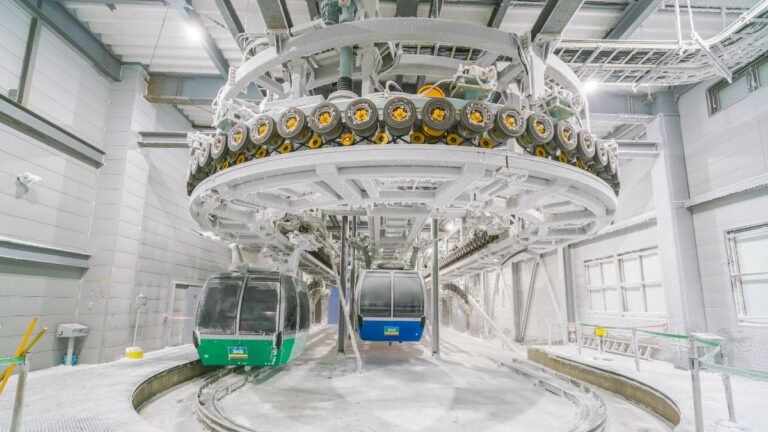Table of Contents
- Introduction
- Smart Compressors and IoT Integration
- Energy Efficiency Through Variable Speed Drives
- Advanced Air Treatment Solutions
- Compressed Air in Renewable Energy Storage
- AI Enhancements in Compressed Air Systems
- Future Trends in Compressed Air Technology
Compressed air is considered the “fourth utility” in manufacturing, alongside water, electricity, and natural gas, due to advancements in efficiency and technology. Intelligent compressors and air treatment technologies enhance production and sustainability in sectors such as automotive and pharmaceuticals, thereby boosting productivity and reducing costs. Additionally, compressed air plays a crucial role in predictive maintenance and renewable energy integration, underscoring its vital contribution to sustainability efforts. For reliable equipment and solutions, businesses can explore the farm and fleet air compressor Jacksonville FL options to ensure optimal performance and energy efficiency. Understanding these developments is crucial for maintaining competitiveness in the evolving industrial landscape.
As industries continue to prioritize energy conservation, compressed air systems are being redesigned to minimize waste and reduce their carbon footprint. The integration of IoT and data analytics further enables real-time monitoring, helping operators detect leaks and inefficiencies instantly. Ultimately, these innovations make compressed air not just a utility, but a strategic asset driving smarter, greener manufacturing operations.
Smart Compressors and IoT Integration
The industrial sector is undergoing a digital revolution, with Internet of Things (IoT) technology leading the charge in compressed air system innovation. Smart compressors outfitted with IoT sensors now provide real-time visibility into system health, energy consumption, and performance analytics. Maintenance teams can receive instant alerts on their mobile devices if an anomaly is detected, minimizing unplanned downtime and extending the lifespan of their equipment. This level of insight fosters continuous improvement, ensuring that compressed air assets run at peak performance and enabling companies to respond quickly to shifting production requirements.
Energy Efficiency Through Variable Speed Drives
Electricity use accounts for the largest operational cost of a compressed air system. Traditional compressors operate at full throttle regardless of demand, wasting energy during periods of low output. Variable Speed Drive (VSD) compressors have addressed this inefficiency by modulating motor speed in response to real-time consumption, thereby reducing unnecessary energy draw and enabling plants to reduce electricity costs by up to 50%. This dynamic approach also reduces mechanical stress, extending the useful life of both motors and compressors while helping companies meet stricter energy regulations.
Advanced Air Treatment Solutions
Industrial compressed air must be free of contaminants, such as water, oil, and particulates, especially in industries with stringent air quality standards, including food, beverage, and pharmaceuticals. Advanced filtration and drying technologies now ensure that compressed air meets or exceeds regulatory standards. Desiccant dryers, coalescing filters, and high-efficiency particulate air (HEPA) solutions have revolutionized how facilities manage air purity. These innovations not only protect sensitive production equipment but also safeguard end products, supporting regulatory compliance and consumer safety.
Compressed Air in Renewable Energy Storage
The rise of renewable energy has introduced new challenges to utility grid stability—namely, how to store energy during periods of low demand for use during peak loads. Compressed Air Energy Storage (CAES) systems address this by storing excess electricity as pressurized air in underground caverns or large tanks. When energy demand surges, the stored air is heated and released to generate electricity. This technology, pioneered at Germany’s Huntorf power plant, is finding new life as utilities seek more sustainable ways to balance renewable energy inputs. New CAES projects are emerging worldwide, offering scalable and efficient storage solutions for the modern grid.
AI Enhancements in Compressed Air Systems
Artificial Intelligence is redefining the role of compressed air systems in industry. AI-driven tools analyze performance data points from across entire production networks, quickly detecting inefficiencies or impending failures that manual inspection might miss. These advanced algorithms recommend optimal maintenance schedules, thereby extending equipment life and reducing operational costs. As a result, businesses can prevent unexpected shutdowns and optimize energy use, achieving higher overall operational reliability.
Future Trends in Compressed Air Technology
The convergence of sustainability, digitization, and the integration of renewable energy is shaping the future of compressed air. Cutting-edge research is focusing on hybrid systems that leverage both traditional compressors and renewable power sources, creating unparalleled flexibility and reliability. The integration of AI and IoT will continue to enhance maintenance strategies and improve asset utilization. These advancements promise to cut costs, shrink carbon footprints, and support greener, more resilient industrial supply chains. As the needs of manufacturers and utilities evolve, compressed air systems will continue to be a vital lever for innovation and progress in industrial automation and sustainability.
Overall, compressed air is evolving well beyond its traditional applications, becoming key to the ongoing transformation of modern industry. From smart manufacturing to renewable energy storage, its journey mirrors the broader shift toward efficiency, sustainability, and data-driven optimization.

